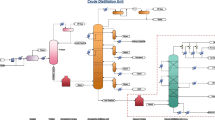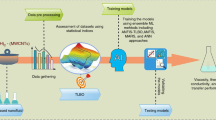Abstract
An optimization process for impellers was carried out based on numerical simulation, Latin hypercube sampling (LHS), surrogate model and Genetic algorithm (GA) to improve the efficiency of residual heat removal pump. The commercial software ANSYS CFX 14.5 was utilized to solve the Reynolds-averaged Navier-Stokes equations by using the Shear stress transport turbulence model. The impeller blade parameters, which contain the blade inlet incidence angle Δβ, blade wrap angle φ, and blade outlet angle β 2, were designed by random sample points according to the LHS method. The efficiency predicted under the design flow rate was selected as the objective function. The best combination of parameters was obtained by calculating the surrogate model with the GA. Meanwhile, the prediction accuracies of three surrogate models, namely, Response surface model (RSM), Kriging model, and Radial basis neural network (RBNN), were compared. Results showed that the calculated findings agree with the experimental performance results of the original pump. The RSF model predicted the highest efficiency, while the RBNN had the highest prediction accuracy. Compared with the simulated efficiency of the original pump, the optimization increased efficiency by 8.34% under the design point. Finally, the internal flow fields were analyzed to understand the mechanism of efficiency improvement. The optimization process, including the comparison of the surrogate models, can provide reference for the optimization design of other pumps.
Similar content being viewed by others
References
P. Liu, X. Long and H. Guan, Discussion about residual heat removal pump in nuclear power plant, Pump Technology, 6 (2008) 18–20.
R. R. Singh and M. Nataraj, Analysis and optimization of pump performance variables using genetic algorithm and taguchi quality concept: A case study, International Journal of Mechanical Engineering application Research, 3 (3) (2012) 185–189.
L. Zhou, W. Shi and S. Wu, Performance optimization in a centrifugal pump impeller by orthogonal experiment and numerical simulation, Advances in Mechanical Engineering, 2013 (2013).
Y. Lian and M. Liou, Multiobjective optimization using coupled response surface model and evolutionary algorithm, AIAA Journal, 43 (6) (2005)1316-1325.
W. Yang and R. Xiao, Multiobjective optimization design of a pump–turbine impeller based on an inverse design using a combination optimization strategy, Journal of Fluids Engineering, 136 (1) (2014) 014501.
C. Wang, H. Peng, J. Ding and D. Liu, Optimization for stype blade of fire pump based on response surface method, Journal of Mechanical Engineering, 49 (10) (2013) 170–177.
R. Zhang, K. Zheng and J. Yang, Investigation on parametric design of centrifugal pump impeller and its optimization with response surface method, ASME 2012 Fluids Engineering Division Summer Meeting collocated with the ASME 2012 Heat Transfer Summer Conference and the ASME 2012 10th International Conference on Nanochannels, Microchannels, and Minichannels, American Society of Mechanical Engineers (2012) 529–533.
Y. Zhang, S. Hu, J. Wu, Y. Zhang and L. Chen, Multiobjective optimization of double suction centrifugal pump using Kriging metamodels, Advances in Engineering Software, 74 (2014)16-26.
X. Wang, C. Hirsch, S. Kang and C. Lacor, Multi-objective optimization of turbomachinery using improved NSGA-II and approximation model, Computer Methods in Applied Mechanics and Engineering, 200 (9) (2011) 883–895.
H. Bing and S. Cao, Optimal design of mixed-flow pump impeller based on direct inverse problem iteration and genetic algorithm, ASME-JSME-KSME 2011 Joint Fluids Engineering Conference, American Society of Mechanical Engineers (2011) 803–810.
J. H. Kim and K. Y. Kim, Analysis and optimization of a vaned diffuser in a mixed flow pump to improve hydrodynamic performance, Journal of Fluids Engineering, 134 (7) (2012) 071104.
J. H. Kim, J. H. Kim, K. Y. Kim, J. Y. Yoon, S. H. Yang and Y. S. Choi, High-efficiency design of a tunnel ventilation jet fan through numerical optimization techniques, Journal of Mechanical Science and Technology, 26 (6) (2012) 1793–1800.
J. H. Kim, H. C. Lee, J. H. Kim, S. Kim, J. Y. Yoon and Y. S. Choi, Design techniques to improve the performance of a centrifugal pump using CFD, Journal of Mechanical Science and Technology, 29 (1) (2015) 215–225.
J. Pei, S. Yuan and W. Wang, Numerical analysis of threedimensional unsteady turbulent flow in circular casing of a high power centrifugal diffuser pump, Advances in Mechanical Engineering (2013).
F. R. Menter, Two-equation eddy viscosity models for engineering applications, AIAA Journal, 32 (8) (1994) 1598–1605.
X. Guan, Modern pumps theory and design, First Ed., China Astronautic Publishing House, Beijing, China (2011).
W. Wang, S. Yuan, J. Pei, J. Zhang, J. Yuan and J. Mao, Optimum hydraulic design for a radial diffuser pump using orthogonal experimental method based on CFD, ASME 2014 4th Joint US-European Fluids Engineering Division Summer Meeting collocated with the ASME 2014 12th International Conference on Nanochannels, Microchannels, and Minichannels, American Society of Mechanical Engineers (2014) V01AT02A002-V01AT02A002.
T. Goel, D. J. Dorney, R. T. Haftka and W. Shyy, Improving the hydrodynamic performance of diffuser vanes via shape optimization, Computers & Fluids, 37 (6) (2008) 705–723.
T. Goel, R. Vaidyanathan, R. T. Haftka, W. Shyy, N. V. Queipo and K. Tucker, Response surface approximation of Pareto optimal front in multi-objective optimization, Computer Methods in Applied mechanics and Engineering, 196 (4) (2007) 879–893.
N. V. Queipo, R. T. Haftka, W. Shyy, T. Goel, R. Vaidyanathan and K. Tucker, Surrogate-based analysis and optimization, Progress in Aerospace Sciences, 41 (1) (2005) 1–28.
S. Derakhshan, B. Mohammadi and A. Nourbakhsh, The comparison of incomplete sensitivities and Genetic algorithms applications in 3D radial turbomachinery blade optimization, Computers & Fluids, 39 (10) (2010) 2022–2029.
X. Yuan, T. Tanuma, X. Zhu, Z. Lin and D. Nomura, A CFD approach to fluid dynamic optimum design of steam turbine stages with stator and rotor blades, ASME Turbo Expo 2010: Power for Land, Sea, and Air, American Society of Mechanical Engineers (2010) 2209–2218.
I. Tsalicoglou and B. Phillipsen, Design of radial turbine meridional profiles using particle swarm optimization, 2 nd International Conference on Engineering Optimization (2010).
Author information
Authors and Affiliations
Corresponding author
Additional information
Recommended by Guest Editor Hyung Hee Cho and Yulin Wu
Wenjie Wang is currently a Ph.D. candidate in the National Research Center of Pumps, Jiangsu University. His research interests include the optimization design and analysis of unsteady flow of centrifugal pump. He received his B.S. degree from Jiangsu University in 2008.
Ji Pei is currently an assistant professor in the National Research Center of Pumps, Jiangsu University. His research interests include unsteady flow, flowinduced vibration, and fluid-structure interaction in turbomachinery. He received his Ph.D. degree from Jiangsu University in 2013.
Shouqi Yuan is currently a professor in the National Research Center of Pumps, Jiangsu University. His research interests include the theory, optimization, and design of fluid machinery. He received his Ph.D. degree from Jiangsu University in 1994.
Rights and permissions
About this article
Cite this article
Wang, W., Pei, J., Yuan, S. et al. Application of different surrogate models on the optimization of centrifugal pump. J Mech Sci Technol 30, 567–574 (2016). https://doi.org/10.1007/s12206-016-0110-0
Received:
Revised:
Accepted:
Published:
Issue Date:
DOI: https://doi.org/10.1007/s12206-016-0110-0




